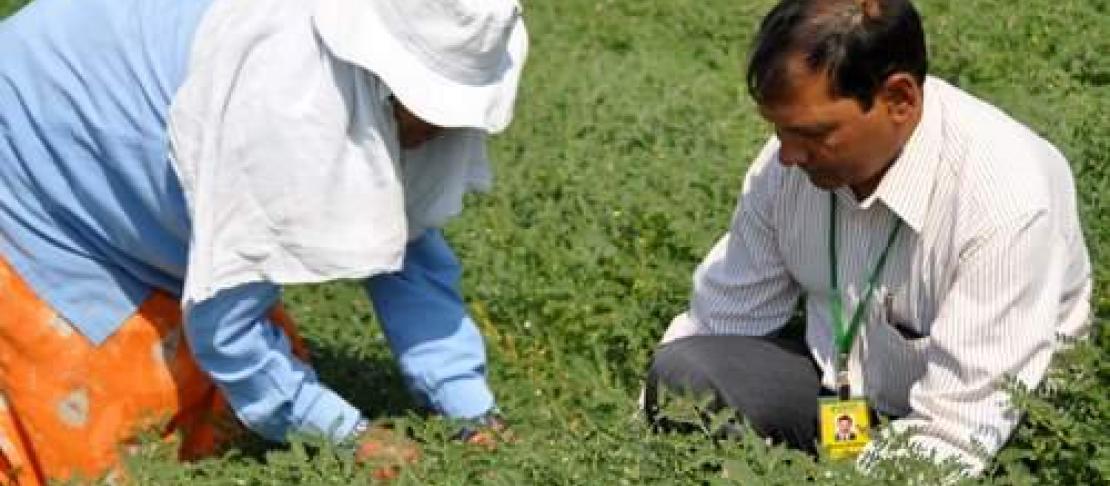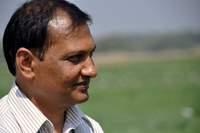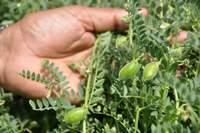The Super Chickpea, and the silent heroes in the war against hunger.

During my past visits to Kenya, Ghana, Mali and Burkina Faso, one common streak always came up when talking to farmers about climate adaptation techniques: they were all actively using new seed varieties for their different crops.
I had not really questioned where those seed varieties came from. I saw them in the shops of commercial seed traders, so I asked no more. A bit like a child does not ask where Santa comes from. A long and complex process of seed selection and breeding remained hidden for me.
A visit to ICRISAT, the International Crops Research Institute for the Semi-Arid Tropics near Hyderabad in India, changed all of that. I discovered the world’s headquarter for the agriculture research on five crops: sorghum, pearl millet, chickpea, pigeonpea and groundnut. And I discovered the link between chickpeas, chickpea heroes and the war against hunger.
Food diets, malnutrition and chickpeas
Sufficient food, but also a balanced food intake are key to battle malnutrition. Often the world’s attention goes to staple foods like rice, maize or wheat. We often forget it takes other crops too, to make a balanced diet, in a global fight against hunger.
Chickpeas is one of those crops, and an important one, as they make up for more than 20 percent of the world pulse production. Chickpeas contain 22-25% proteins, and 2-3 times more iron and zinc than wheat. Chickpea protein quality is better than other pulses. …
So understandably, agricultural researchers, like Dr. Pooran M.Gaur, a principal scientist and chickpea breeder at ICRISAT, make continuous efforts to develop new chickpea varieties, adapted to fast changing environmental conditions. “Super Chickpeas”, as it were. Bred by –what I would not hesitate to call - “super scientists”, in the quiet isolation of agricultural research centers.
Agricultural research in service of food security
 I meet Pooran amidst the ICRISAT chickpea test fields in Patancheru, near Hyderabad in India. He tells me a story which illustrates the importance, and profound impact agricultural research can have on food production, and food security: “In India, for hundreds of years, chickpeas have been grown in the relatively colder Northern areas during the dry winter season where they flourish in temperatures of 20 to 30 dgr C. The traditional chickpea varieties were not really suitable for the climate here in Andhra Pradesh for instance. They were late maturing and required longer duration (more than 120 days) to grow. That stretched the crop to grow into the hot season and moisture stress conditions. Ten years ago, only 160,000 hectares of chickpeas were grown in this state. The yield was only about 600 kgs/hectare.”
I meet Pooran amidst the ICRISAT chickpea test fields in Patancheru, near Hyderabad in India. He tells me a story which illustrates the importance, and profound impact agricultural research can have on food production, and food security: “In India, for hundreds of years, chickpeas have been grown in the relatively colder Northern areas during the dry winter season where they flourish in temperatures of 20 to 30 dgr C. The traditional chickpea varieties were not really suitable for the climate here in Andhra Pradesh for instance. They were late maturing and required longer duration (more than 120 days) to grow. That stretched the crop to grow into the hot season and moisture stress conditions. Ten years ago, only 160,000 hectares of chickpeas were grown in this state. The yield was only about 600 kgs/hectare.”
But things changed in recent years. Using a combination of different chickpea seed varieties which had a shorter growing season, and which were more resistant to higher temperatures, agricultural researchers like Pooran were able to breed varieties which needed only 90 to 95 days to mature.
“We distributed samples of these new varieties to universities and government institutes who tested them, and were impressed about the results. One particular variety, released as “JG11”, has thoroughly impacted the production of chickpeas in India, especially in the South.”
JG11 was rapidly adopted by many farmers in central and southern India. “Here in Andhra Pradesh, in just a few years, the total surface of chickpea cultivation increased to 630,000 hectares, a fourfold from before. But even more importantly, the average yield increased from 600 to 1,400 kgs/hectare, almost three times as much.”, Pooran explains.
Knowing how important chickpeas are in the typical Indian diet, one can say the impact of the new variety’s ninefold production increase had a profound impact.
But it is not the end of the road for chickpeas
 As the “Super Chickpea” early varieties - like JG11 - are now widely used in India, and different parts of Asia and Africa, ICRISAT concentrates on other new varieties to help farmers adapt to the ever changing climate and environmental conditions.
As the “Super Chickpea” early varieties - like JG11 - are now widely used in India, and different parts of Asia and Africa, ICRISAT concentrates on other new varieties to help farmers adapt to the ever changing climate and environmental conditions.
“We use various parameters to select our breeding materials”, Pooran stresses. “We are developing varieties which are early maturing and high yielding, tolerant to drought and heat stresses, resistant to deceases and insect infestation, and have good seed quality”
ICRISAT supplies improved breeding lines to universities and government research institutes, who select the best lines, and release these as varieties. Further down the seed chain, the research institutes produce “breeder seed” which is used by the public and private seed sectors to produce “foundation seeds” and then “certified seeds”, which are sold to the farmers.
Up to now, ICRISAT -bred chickpea materials have led to the release of 73 new varieties in 10 countries.
Working for impact.
I ask Pooran if after 25 years working as a chickpea breeder, he ever thought of moving to another crop? “No way”, he answers, “chickpeas are ‘it’ for me. The world produces about 9 million tons of chickpeas per year, in 50 countries. These are not only used for their own production, but also as a cash crop, as over 140 countries import chickpeas. So the demand is high. For the poor in the world, combined with a staple food of rice, maize, sorghum, millet or any wheat, chickpeas make a perfect diet. It contains a lot of protein and is rich in minerals, amino acids and several vitamins.”
“But there is more to it: Chickpea is a hardy crop and can be grown in marginal lands on residual moisture, where the high-input crops fail to give economic returns. It is able to take much of its nitrogen requirement from the atmosphere by forming a symbiotic association with soil bacteria called rhizobium, and thus does not need much fertilizer.”
So when asked what his dream is, Pooran answers: “I would like to increase the global awareness of the qualities of chickpeas. Here at ICRISAT, we have already directly contributed to new varieties now used in semi-arid areas in several countries, including Kenya, Tanzania and Ethiopia, which are prone to hunger and malnutrition. But we can spread it further. We also need to emphasize to farmers that chickpeas are not just a low input or a diversity crop: with the new varieties we are breeding now, farmers should be able to select those varieties adapted to their fields, and the changing weather. They need to be taught proper crop production technologies, so their yields can further increase”.
“Mr Super Chickpea”, is clearly a man with a mission. And he is not alone in the battle against hunger. Every day, dozens of researchers at ICRISAT, and thousands like them in similar research institutes join in his cause, helping farmers around the globe to adapt to climate change.
We can rightfully call them, “the silent heroes in the war against hunger”.
The way ahead for researchers and smallholder farmers facing current and coming challenges posed by climate change lies in learning from each other while sharing knowledge and experiences.
Photos in this article by Peter Casier.